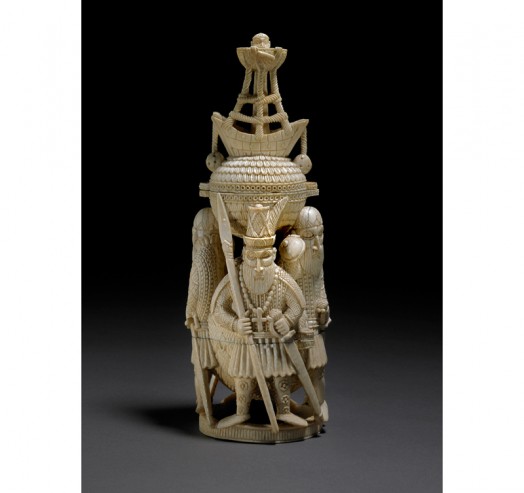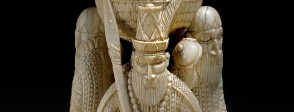
Early trade with Europeans
Well before European seafarers reached the coast of West Africa, goods were being carried overland from the Mediterranean, across the Sahara to great trading centres such as Timbuktu, and onwards into forest regions such as Benin in present-day Nigeria. Going in the opposite direction, gold was the most valuable product of West Africa to reach Europe and Asia during the medieval period. Gold was mined in the regions far to the west of Benin and it was in their efforts to find a way around the overland routes, which the Africans controlled, that the Portuguese arrived in the coastal territories of Benin in the late AD 1400s.
By the 16th century, Benin was trading pepper, gum, cloth, ivory and slaves with the Portuguese in exchange for brass, lead, iron, coral, cowrie shells (used for currency), firearms, spirits and luxury goods. The Oba (king) of Benin himself was in control of the supply of goods which could be traded to the Europeans on the coast so that all the profit went to support his court and government. Other merchants could only trade with his permission. The Europeans themselves were seldom allowed to travel inland or to visit Benin City, in order to avoid them trading without the authority of the Oba.
The salt cellar
Since art was an important way of communicating his authority, the Oba also controlled the output of the palace workshops. Ivory carvings were traditionally produced only for the royal court, but the Oba gave permission for decorated salt cellars, horns, spoons and forks to be made for European visitors. These luxury goods are possibly the earliest examples from Africa of objects made specifically as souvenirs for foreigners. They seem to have been produced in a compromise between African and western styles and the images they depict were probably based on European prints and coins rather than first-hand observation. For example, wooden joinery was largely unknown in Benin, so the planks of the ship’s hull on this salt cellar appear like the roof shingles that were used on the Oba’s palace. The figure in the middle, with spear, sword and crucifix, is believed by some to have been copied from an official portrait of Afonso de Albuquerque, an important Portuguese general and empire-builder.
However, Europeans were not only shown on the art objects intended for them. They also appear on ivory objects such as hip masks used by the Oba in rituals, on the brass plaques that decorated the wooden beams and posts of the royal palace and as free-standing brass figures that were probably placed on royal altars – see For the classroom. The Oba’s power over the ocean and river trade routes by which European goods came to Benin was associated in myth with his defeat in battle of Olokun, the white-faced ruler of the sea and provider of wealth. According to this myth the Oba fought with Olokun on the beach, subdued him and stripped him of his wealth. Europeans, some of whom fought as mercenaries in the Oba’s army, were regarded as messengers from Olokun and thus as subject to the Oba’s authority and symbols of his wealth and power, to which, in turn, their trade contributed so much.
Brass from Europe
It is likely that trade with the Portuguese encouraged the growth of brass casting in Benin. The technology of brass casting had been developed in West Africa as early as the AD 900s, but the region could not produce enough metal to supply the demands of the royal palace of Benin. The Portuguese thus found a ready market for brass ingots, often made in the form of bracelets called manillas, which were melted down and made into works of art such as the Benin brass plaques. The number of manillas in circulation increased dramatically from the AD 1500s when they became one of the standard trade currencies. Millions were made in Europe, mainly in the Low Countries (present-day Netherlands), along with brass and copper pots and pans, and imported into Africa.
More information
Plaque showing the Oba with Europeans
BBC History of the World in 100 objects: a brass plaque showing the Oba with Europeans; listen to the programme or read the transcript; with close-up details.
http://www.bbc.co.uk/ahistoryoftheworld/objects/rmAT6B7zTZCGACd7i7l6Wg
Ivory armlet linking the Oba with Olokun
Ivory armlet linking the Oba with Olokun, god of the sea.
http://www.britishmuseum.org/explore/highlights/highlight_objects/aoa/i/ivory_armlet.aspx
Another ivory salt cellar from Benin
http://www.britishmuseum.org/explore/highlights/highlight_objects/aoa/i/ivory_salt_cellar.aspx
BBC Lost Kingdoms of Africa: West Africa
Presented by Gus Casely-Hayford: 1:30 – 17:30.
https://www.youtube.com/watch?v=Je0K0BAJ1hY
Views from Africa
Views from Africa: online tour of Europeans seen through the eyes of African artists.
http://www.britishmuseum.org/explore/online_tours/africa/views_from_africa/views_from_africa.aspx
BBC History article on Vasco da Gama
http://www.bbc.co.uk/history/british/tudors/vasco_da_gama_01.shtml
Pocket Explorer: African civilizations
Nicholas Badcott, Pocket Explorer: African civilizations, British Museum Press, 2010
The art of Benin
Paula Girshick Ben-Amos, The art of Benin, British Museum Press, 1995
More information
-
Plaque showing the Oba with Europeans
BBC History of the World in 100 objects: a brass plaque showing the Oba with Europeans; listen to the programme or read the transcript; with close-up details.
Source: bbc.co.uk
-
Ivory armlet linking the Oba with Olokun
Ivory armlet linking the Oba with Olokun, god of the sea.
Source: britishmuseum.org
-
Another ivory salt cellar from Benin
Source: britishmuseum.org
-
BBC Lost Kingdoms of Africa: West Africa
Presented by Gus Casely-Hayford: 1:30 – 17:30.
Source: youtube.com
-
Views from Africa
Views from Africa: online tour of Europeans seen through the eyes of African artists.
Source: britishmuseum.org
-
BBC History article on Vasco da Gama
Source: bbc.co.uk
-
Pocket Explorer: African civilizations
Nicholas Badcott, Pocket Explorer: African civilizations, British Museum Press, 2010
Source: British Museum Press
-
The art of Benin
Paula Girshick Ben-Amos, The art of Benin, British Museum Press, 1995
Source: British Museum Press


